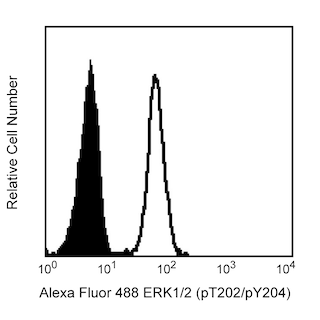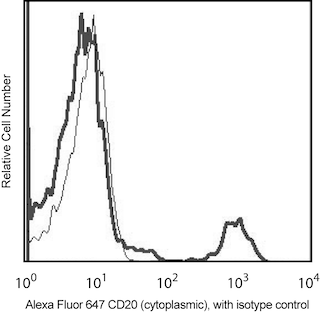Old Browser
This page has been recently translated and is available in French now.
Looks like you're visiting us from {countryName}.
Would you like to stay on the current country site or be switched to your country?


.png)

Multiparameter flow cytometric analysis of human STING expression in human peripheral blood leukocytes. Human blood was treated with BD Phosflow™ Lyse/Fix Buffer (Cat. No. 558049) followed by permeabilization with BD Perm/Wash™ Buffer (Cat. No. 554723). Cells were then stained with Alexa Fluor® 647 Mouse Anti-Human CD20 antibody (Cat. No. 558054) and either BD Horizon™ PE-CF594 IgG1, κ Isotype Control (Cat. No. 562292; Top Panels) or BD Horizon PE-CF594 Mouse Anti-Human STING antibody (Cat. No. 565313; Bottom Panels). Left Panels - Contour plots showing the correlated expression of STING (or Ig Isotype control staining) versus Side Light Scatter (SSC-A) were derived from gated events with the forward and side light-scatter characteristics of intact leucocytes. Right Panels - Contour plots showing the correlated expression of STING (or Ig Isotype control staining) versus CD20 were derived from gated events with the forward and side light-scatter characteristics of intact lymphocytes. Flow cytometric analysis was performed using a BD LSRFortessa™ Cell Analyzer System.
.png)

BD Horizon™ PE-CF594 Mouse Anti-Human STING
.png)
Regulatory Status Legend
Any use of products other than the permitted use without the express written authorization of Becton, Dickinson and Company is strictly prohibited.
Preparation And Storage
Product Notices
- This reagent has been pre-diluted for use at the recommended Volume per Test. We typically use 1 × 10^6 cells in a 100-µl experimental sample (a test).
- An isotype control should be used at the same concentration as the antibody of interest.
- Caution: Sodium azide yields highly toxic hydrazoic acid under acidic conditions. Dilute azide compounds in running water before discarding to avoid accumulation of potentially explosive deposits in plumbing.
- Source of all serum proteins is from USDA inspected abattoirs located in the United States.
- When excited by the yellow-green (561-nm) laser, the fluorescence may be brighter than when excited by the blue (488-nm) laser.
- Because of the broad absorption spectrum of the tandem fluorochrome, extra care must be taken when using multi-laser cytometers, which may directly excite both PE and CF™594.
- Please observe the following precautions: Absorption of visible light can significantly alter the energy transfer occurring in any tandem fluorochrome conjugate; therefore, we recommend that special precautions be taken (such as wrapping vials, tubes, or racks in aluminum foil) to prevent exposure of conjugated reagents, including cells stained with those reagents, to room illumination.
- Species cross-reactivity detected in product development may not have been confirmed on every format and/or application.
- CF™ is a trademark of Biotium, Inc.
- This product is provided under an Agreement between BIOTIUM and BD Biosciences. The manufacture, use, sale, offer for sale, or import of this product is subject to one or more patents or pending applications owned or licensed by Biotium, Inc. This product, and only in the amount purchased by buyer, may be used solely for buyer’s own internal research, in a manner consistent with the accompanying product literature. No other right to use, sell or otherwise transfer (a) this product, or (b) its components is hereby granted expressly, by implication or by estoppel. This product is for research use only. Diagnostic uses require a separate license from Biotium, Inc. For information on purchasing a license to this product including for purposes other than research, contact Biotium, Inc., 3159 Corporate Place, Hayward, CA 94545, Tel: (510) 265-1027. Fax: (510) 265-1352. Email: btinfo@biotium.com.
- Texas Red is a registered trademark of Molecular Probes, Inc., Eugene, OR.
- For fluorochrome spectra and suitable instrument settings, please refer to our Multicolor Flow Cytometry web page at www.bdbiosciences.com/colors.
- Please refer to www.bdbiosciences.com/us/s/resources for technical protocols.
Companion Products




.png?imwidth=320)

The T3-680 monoclonal antibody specifically recognizes human STING (Stimulator of interferon genes protein) which is also known as Endoplasmic reticulum interferon stimulator (ERIS) and Mediator of IRF3 activation (MITA). STING is encoded by TMEM173 (Transmembrane protein 173). STING is a multi-pass transmembrane adaptor protein which is widely expressed in the endoplasmic reticulum of cells. STING acts as a sensor of cytosolic double-stranded DNA derived from bacteria and viruses and promotes the production of type I interferons, IFN-α and IFN-β. Following activation, STING translocates with TBK1 kinase to perinuclear endosomes. The TBK1 kinase phosphorylates and activates interferon regulatory factors, such as IRF3, and NF-κB, which leads to the induction of type I interferon and other immune response genes that play roles in innate and adaptive immunity.
This antibody is conjugated to BD Horizon PE-CF594, which has been developed exclusively by BD Biosciences as a better alternative to PE-Texas Red®. PE-CF594 excites and emits at similar wavelengths to PE-Texas Red® yet exhibits improved brightness and spectral characteristics. Due to PE having maximal absorption peaks at 496 nm and 564 nm, PE-CF594 can be excited by the blue (488-nm), green (532-nm) and yellow-green (561-nm) lasers and can be detected with the same filter set as PE-Texas Red® (eg, 610/20-nm filter).

Development References (6)
-
Ablasser A, Goldeck M, Cavlar T, et al. cGAS produces a 2'-5'-linked cyclic dinucleotide second messenger that activates STING. Nature. 2013; 498(7454):380-384. (Biology). View Reference
-
Ishikawa H, Barber GN. STING is an endoplasmic reticulum adaptor that facilitates innate immune signalling. Nature. 2008; 455(7213):674-678. (Biology). View Reference
-
Sun L, Wu J, Du F, Chen X, Chen ZJ. Cyclic GMP-AMP synthase is a cytosolic DNA sensor that activates the type I interferon pathway. Science. 2012; 339(6121):786-791. (Biology). View Reference
-
Unterholzner L, Keating SE, Baran M, et al. IFI16 is an innate immune sensor for intracellular DNA. Nat Immunol. 2010; 11(11):997-1004. (Biology). View Reference
-
Woo SR, Corrales L, Gajewski TF. The STING pathway and the T cell-inflamed tumor microenvironment. Trends Immunol. 2015; 36(4):250-256. (Biology). View Reference
-
Zhang Z, Yuan B, Bao M, Lu N, Kim T, Liu YJ. The helicase DDX41 senses intracellular DNA mediated by the adaptor STING in dendritic cells. Nat Immunol. 2012; 12(10):959-965. (Biology). View Reference
Please refer to Support Documents for Quality Certificates
Global - Refer to manufacturer's instructions for use and related User Manuals and Technical data sheets before using this products as described
Comparisons, where applicable, are made against older BD Technology, manual methods or are general performance claims. Comparisons are not made against non-BD technologies, unless otherwise noted.
For Research Use Only. Not for use in diagnostic or therapeutic procedures.